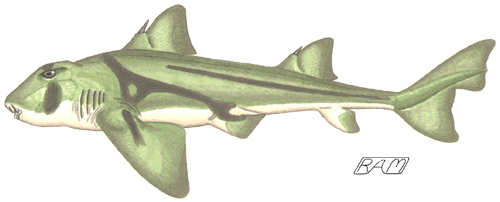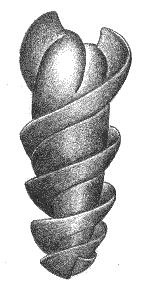Port Jackson Shark Egg Placement

An early draft of the Heterodontiformes overview was posted to Shark-L. After this posting, a subscriber wrote that she would never call them selachian Einsteins, and questioned my comment about placing their eggs in crevices. Based on her aquarium observations, she felt they were indiscriminately laid, and merely washed into these protective nooks. I responded:
I appreciate your qualms about the supposed selective oviposition behavior in Port Jackson — or PJ — sharks (Heterodontus portusjacksoni). And your caution in drawing firm conclusions from the behavior of captive individuals seems to me highly laudable. Admittedly, the case for mother PJ's actively wedging their auger-shaped egg cases into crevices is largely circumstantial, but — I believe — fairly compelling.
I have never observed a PJ to wedge an egg case into a crevice, either in captivity or the wild. However, during August and September 1987 at depths of 10 to 25 metres off Newcastle, NSW, I have personally observed PJ egg-carrying twice (the shark was definitely female in both cases) and I apparently interrupted PJ egg-laying on one occasion (the mother abandoned her single, freshly extruded egg case on the sandy bottom as I approached); I have tugged at several single PJ egg cases in crevices on the rocky reef (and have once seen three PJ egg cases fairly crowded into the same crevice) and found them all to be oriented wide-end outermost and tightly wedged in place. In all fairness, I have also seen a hardened PJ egg case lying in the open on an underwater sandy plain, rolling gently in the bottom swells; I don't know how it got there, but any number of vectors — both biotic and abiotic — may have played a role. Taphonomy of marine egg cases is a field still in its infancy.
 In their classic 1971 study (Ecol.Monogr., 41(4): 271-89), McLaughlin and
O'Gower discuss oviposition in PJ's, reporting that the only PJ egg-laying event
they observed was in captivity, noting that "In this instance, the female
made no attempt to anchor the capsule, and indeed all eggs deposited in the
holding pool appeared to have been distributed randomly over the bottom.
However, the pool lacked the crevices and fissures which characterize natural
oviposition sites." McLaughlin and O'Gower conclude their remarks as
follows: "Waite (1896) suggested that the eggs of H. portusjacksoni
became anchored as a result of water movements, and although we have found some
living eggs lying free on the bottom, the location and orientation of the
majority indicate active participation by the female in their placement."
These authors then follow up this interpretation with reports from the
literature of other elasmobranchs apparently using bottom topography to secure
their eggs (see pp 275-6). Compagno (1984; p 161) writes of the PJ, "Eggs
are oriented with their pointed ends into crevices, and females have been
observed carrying eggs, suggesting that females lay their eggs, pick them up at
the broad end, and insert them into appropriate crevices." Michael (1993; p
38) notes that in the Port Jackson shark, "Adults observed eating their own
eggcases" (supporting part of your hypothesis, as quoted above), but on p
18 states that, "The female will take the newly laid eggcase in her mouth
and insert it under or in a benthic structure. One female was also observed to
slap an eggcase in an interstice with her tail." Tricas, McCosker, and
Walker (1997; p 143) state the in the PJ shark, "The female will wedge the
pointed edge and flanges of the screw-shaped egg into a rocky crevice using her
mouth."
In their classic 1971 study (Ecol.Monogr., 41(4): 271-89), McLaughlin and
O'Gower discuss oviposition in PJ's, reporting that the only PJ egg-laying event
they observed was in captivity, noting that "In this instance, the female
made no attempt to anchor the capsule, and indeed all eggs deposited in the
holding pool appeared to have been distributed randomly over the bottom.
However, the pool lacked the crevices and fissures which characterize natural
oviposition sites." McLaughlin and O'Gower conclude their remarks as
follows: "Waite (1896) suggested that the eggs of H. portusjacksoni
became anchored as a result of water movements, and although we have found some
living eggs lying free on the bottom, the location and orientation of the
majority indicate active participation by the female in their placement."
These authors then follow up this interpretation with reports from the
literature of other elasmobranchs apparently using bottom topography to secure
their eggs (see pp 275-6). Compagno (1984; p 161) writes of the PJ, "Eggs
are oriented with their pointed ends into crevices, and females have been
observed carrying eggs, suggesting that females lay their eggs, pick them up at
the broad end, and insert them into appropriate crevices." Michael (1993; p
38) notes that in the Port Jackson shark, "Adults observed eating their own
eggcases" (supporting part of your hypothesis, as quoted above), but on p
18 states that, "The female will take the newly laid eggcase in her mouth
and insert it under or in a benthic structure. One female was also observed to
slap an eggcase in an interstice with her tail." Tricas, McCosker, and
Walker (1997; p 143) state the in the PJ shark, "The female will wedge the
pointed edge and flanges of the screw-shaped egg into a rocky crevice using her
mouth."
Thus, observational evidence and numerous reports in the elasmobranch literature suggest (but by no means prove conclusively) that female PJ's do indeed actively place or wedge their freshly-laid egg cases inside crevices in the wild, but may often be inhibited or prevented from doing so in captivity.
That said, if anyone can show that my interpretation of the available evidence is faulty or provide evidence that my provisional conclusions are unwarranted, please let me know. I don't care whether my tentative position on this issue is eventually borne out or shown to be naive and ill-informed. I just want to know the truth of the matter, whatever it turns out to be.
Cheers,
R. Aidan Martin
[ Posted to SHARK-L Jan 20 & 21, 1998]
